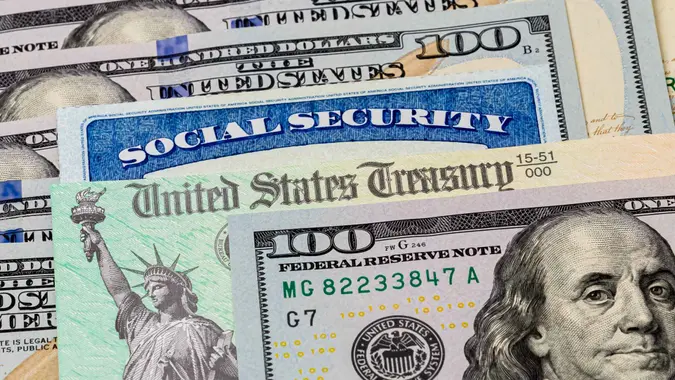Retirement Savings: Your Growing IRA Balance Might Cost You — Don’t Get Caught Off Guard at Tax Time

Commitment to Our Readers
GOBankingRates' editorial team is committed to bringing you unbiased reviews and information. We use data-driven methodologies to evaluate financial products and services - our reviews and ratings are not influenced by advertisers. You can read more about our editorial guidelines and our products and services review methodology.

20 Years
Helping You Live Richer

Reviewed
by Experts

Trusted by
Millions of Readers
Let’s get this out of the way upfront: Having a large IRA balance isn’t exactly a “problem” as much as something you need to plan around. The unfortunate truth is that no matter how much money you have in a traditional IRA, you’ll never end up with the full amount in your pocket.
This is because all distributions from a traditional IRA are fully taxable as ordinary income, the same as if it was your paycheck. That means that if you’re in the top income tax bracket, you’ll pay out 37% of everything you take from your IRA back to the IRS — and then you’ll have to deal with your state taxing authority, if applicable. The bottom line is that in a high-tax state, high earners may have to fork over as much half of their IRA balance as they draw it down.
Knowing this ahead of time, however, can allow you to develop investment and withdrawal strategies that can keep down your tax bite by the time you retire. Here are some suggestions.
Fund a Roth IRA
Funding a Roth IRA is the best way to reduce your taxable distributions in retirement. This is because qualified withdrawals from a Roth IRA are always tax-free, as you already “bit the bullet” by funding a Roth IRA with after-tax money. The tradeoff is that you won’t get a tax deduction for your Roth contributions.
However, some analysts think that the tax deduction for IRA contributions is overrated, as you’re essentially just borrowing from the government now in exchange for paying those taxes later. Additionally, current tax rates are relatively low, at least from a historical standpoint. Taking a tax deduction now, when rates are low, and then paying tax on your distributions when tax rates are potentially higher is a bad tradeoff.
Convert to a Roth IRA
If you’ve got the money to satisfy your tax obligations, convert your traditional IRA into a Roth IRA now. While you’ll have to pay tax on the full amount of your distribution — the same as you would if you were taking a retirement withdrawal — your money will then grow tax-free in a Roth IRA, and your distributions will also ultimately be tax-free. Paying the tax now protects you from having to pay taxes on the balance of your account when you retire, when it should be significantly larger.
Imagine you’re 40 years old now and have a $100,000 traditional IRA. If you convert the full amount to a Roth and are in the top 37% tax bracket, you’ll pay a hefty $37,000 in taxes now. However, if that account grows to $700,000 by the time you turn age 65 — as it would with less than an 8% average annual return — your tax bill would skyrocket to $259,000 if you took it all out as a lump sum.
By converting to a Roth IRA, however, you’ll pay the $37,000 in tax now but won’t pay anything at all when you take your retirement distributions. In this theoretical example, you’d save hundreds of thousands of dollars in taxes.
Make After-Tax Contributions
Although traditionally, contributions to IRAs and 401(k) plans are tax-deductible, you aren’t forced to take that deduction. You can instead opt to make after-tax contributions to these types of qualified retirement plans. As with a Roth IRA, you will forgo the tax deduction now, but in return, you’ll be able to withdraw both your contributions and your earnings from these accounts tax-free. That’s an easy way to reduce your tax bill in retirement.
Use Qualified Charitable Distributions
If you’re charitably minded, you can use your IRA to both fund your favorite charity and reduce your tax blow at the same time. If you’re 70.5 years of age or older, you can make a qualified charitable distribution directly from your IRA to a charity, with the distribution being completely non-taxable to you.
Of course, you won’t get to use the money yourself, but it’s a much more tax-efficient strategy than taking a taxable withdrawal from your IRA and then using it to fund a charitable donation.
Withdraw More in Lower-Tax Years
If your goal is to lower your tax bill as much as possible, plan your retirement distributions so that you withdraw more money in lower-tax years. For example, if you receive a final bonus, take a lump-sum pension payout, earn a large amount of income from side jobs or have a successful year day trading stocks, the last thing you want to do is take a large taxable distribution from your IRA or 401(k) plan.
Instead, wait for a year in which your taxable earnings are lower so that you can take a larger amount out of your retirement plan and still remain in a lower tax bracket.
Take Minimum Distributions Only
If you’re in the financial position where you don’t necessarily have to live off your retirement plan earnings, then you should withdraw as little as possible from your accounts. While traditional IRA and 401(k) plans require minimum distributions after you reach age 70.5, you should restrict yourself to these amounts if you can afford to do so. This will reduce your taxable income and thereby shrink your tax bill as a consequence.
More From GOBankingRates
 Written by
Written by  Edited by
Edited by 

























